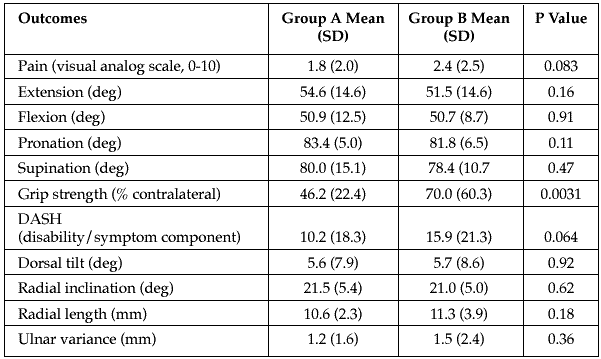
Fri., 10/9/09 Upper Extremity, Paper #53, 12:14 pm OTA-2009
Effects of Brachioradialis Lengthening and Pronator Quadratus Repair on Outcomes following Volar Plating of Distal Radius Fractures
Stuart Hershman, MD (n); Igor Immerman, MD (n); Christopher Bechtel, BS (n);
Michael Walsh, PhD (n); Nader Paksima, DO (4, 5A, 7-Stryker; 7, 8-Small Bone Innovations;
7-EBI; DePuy, A Johnson &Johnson Company; Synthes); Kenneth A. Egol, MD (5B-Exactech, Inc; 7-Biomet, Smith &Nephew, Stryker, Synthes; 8-Johnson &Johnson);
NYU Hospital for Joint Diseases, New York, New York, USA
Purpose: The purpose of this study was to evaluate the effects of pronator quadratus (PQ) repair and brachioradialis tendon (BR) lengthening on functional and radiographic outcomes following volar plating of distal radius fractures. It was hypothesized that at 1 year postoperatively, no significant differences in radiographic measurements, grip strength, range of motion (ROM), pain, or Disability of the Arm, Shoulder and Hand (DASH) scores will be seen between patients with or without BR lengthening and PQ repair.
Methods: 606 patients with distal radius fractures (OTA 23-A through 23-C) over a 3-year period were enrolled in an IRB-approved prospective database. 141 patients who underwent open reduction and internal fixation with a volar plate and had a minimum of 1-year follow-up were included in this study. Patients were identified by whether the BR was lengthened and the PQ was repaired (group A) or not (group B). All patients followed a similar postoperative protocol of a short-arm splint for 1 to 2 weeks, followed by ROM and occupational therapy, with resumption of full weightbearing at 6 weeks. At 1 year, ROM and grip strength were measured, and pain levels and DASH scores were assessed by independent observers. Standard wrist radiographs were reviewed. Statistical analysis was performed using the Student t test and Fisher exact test.
Results: There were 68 patients in group A and 73 patients in group B. Both groups were similar in terms of age, gender, body mass index, hand dominance, and OTA fracture classification. At 1 year postoperatively, there were no statistically significant differences between the groups with respect to pain, range of motion, DASH scores, or radiographic outcomes. Group B demonstrated a significantly higher grip strength, but this was not associated with better functional scores (see table below). There were no cases of tendinosis or tendon rupture.

Conclusion: The results of this study suggest that at 1-year follow-up, there is no clinically significant functional benefit or detriment to lengthening the BR and repairing the PQ after volar plating of distal radius fractures. Overall, volar plating of distal radius fractures leads to good functional outcomes at 1-year follow-up.
• The FDA has not cleared this drug and/or medical device for the use described in this presentation (i.e., the drug or medical device is being discussed for an “off label” use). ◆FDA information not available at time of printing. Δ OTA Grant